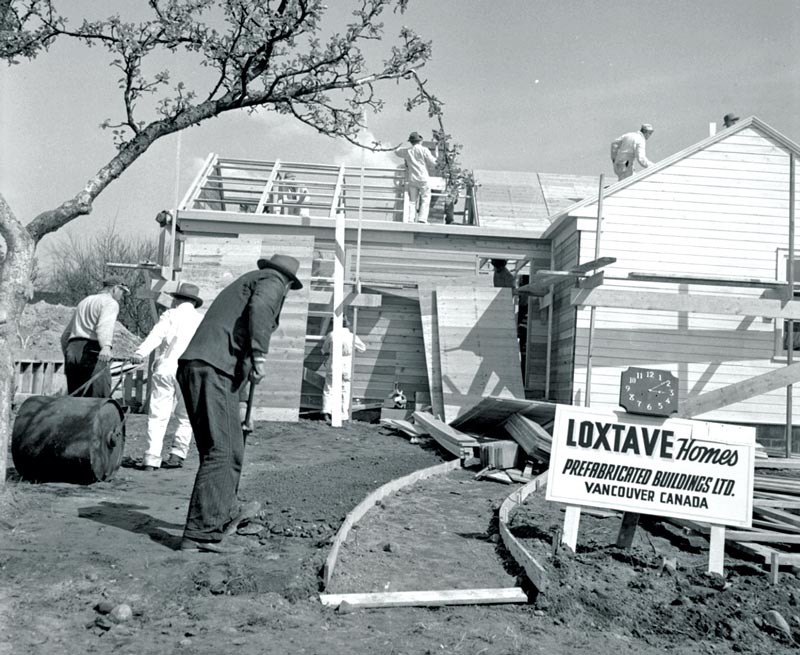Mark Carney is no wartime homebuilder
The PM’s market-oriented solutions bear little resemblance to the wartime housing policies he claims are his inspiration

Workers complete a wartime home in Vancouver in May 1944. Photo by Harry Rowed/NFB.
Mark Carney has consistently drawn parallels between his government’s $25 billion housing program and the wartime policies that ended the housing crisis of the 1940s.
The comparison is not entirely unreasonable. Both were devised in response to housing shortages caused by economic downturns, a scarcity of skilled labour, and rapid migration to urban centres. Both were launched on a backdrop of rising rentierism, widespread evictions, and overcrowding. Both involved the creation of new Crown corporations, the opening of public lands, and the use of prefabricated construction techniques.
By all appearances Carney’s policies are an honest attempt to replicate the success of Second World War-era housing strategies. But the devil is in the details. On closer inspection, the Liberal’s housing strategy is built on the sand of market forces, an error which the policy makers of the 1940s studiously avoided.
Carney has promised to establish a new Crown corporation, Build Canada Homes (BCH), which will be tasked with constructing affordable housing at scale through the power of public-private partnerships, or P3s. BCH will swing no hammers and own no property. Instead it will take on financing and project management responsibilities. Homes built by private firms with federal dollars will be immediately sold on the open market. However, there is no guarantee they will be sold to the people who need them most. There is nothing to prevent speculators, landlords, and financialized firms from purchasing them, and there is no indication that they will come with affordability covenants designed to prevent buyers from charging exorbitant rents, flipping them into million-dollar investments, or using them as short-term rentals.
Carney’s market-based approach to the housing crisis stands in a stark contract to the operational model of Wartime Housing Limited (WHL), the Crown corporation created to solve the housing crisis during and after the war.
WHL differs from BCH in several important ways. While BCH is explicitly a P3 endeavour, mission-focused on creating privatized housing, WHL was tasked with building, owning, and managing homes under the umbrella of the federal government. WHL hired architects and builders to execute housing projects according to company designs. Once the homes were ready, the government retained ownership of the units and then rented them out at cost. From 1941 to 1947 WHL built, owned, and managed tens of thousands of homes. But WHL didn’t stop at houses; they built multi-unit residences, schools, fire-halls, pump-houses, community centres, and office buildings. The wartime housing strategy was about more than housing—it was a massive investment in public infrastructure aimed at meeting social needs.
The wartime initiative did have its detractors. Finance Minister J.L. Ilsley went as far as to describe the program as “dangerous” saying that it would end with the “socialization of all our housing […] with probable disastrous results to our present economic policy of private home ownership.”
Despite the minister’s hysterics, the federal government’s intrusion into the market proved remarkably successful. Public investment in non-market housing and early forms of rent control brought the housing crisis of the 1940s to a close. By the end of the war affordability was restored and rentiers were no longer able to dominate either the housing market or the paycheques of working Canadians. WHL’s approach worked largely because it ensured the homes it built were kept out of the hands of landlords and housing speculators.
These accomplishments did not go unnoticed. The post-war Advisory Committee on Reconstruction recommended the federal government create a national program to provide low- and moderate-income housing across the country in the vein of WHL.
Unfortunately, in 1947 Ottawa went the other way. Parliament folded WHL into the newly founded Canada Mortgage and Housing Corporation (CMHC) and refocused federal policy on promoting individual home ownership through the private sector. The stock of affordable housing built by WHL was privatized and, in a move that prefigured Margaret Thatcher’s ‘right-to-buy’ legislation, sold to its occupants.
Reflecting on the wartime housing strategy, architect and urban policy advisor to the CMHC Humphrey Carver described the government’s decision to liquidate WHL and its assets as pure ideology: “the prospect of the federal government becoming landlord to even more than 40,000 families horrified a Liberal government that was dedicated to private enterprise and would do almost anything to avoid getting into a policy of public housing.”
Ultimately, it was Ottawa’s distaste for any initiative that stepped outside the bounds of capitalist orthodoxy that prompted the government to divest itself from the equitable housing system it had worked so hard to create.
After the dissolution of WHL in 1947 federal housing policy was redirected towards corporate subsidies, mortgage insurance, and other forms of market-welfare. The government’s withdrawal from direct housing provision ceded the market to private interests which then instigated a second housing crisis 25 years later. This repeat crisis was only solved with the reintroduction of both rent control and large scale investment in non-market housing.
Over the past three decades our governments have once again walked away from direct housing provision and, for the third time in a century, allowed the private sector to make a mess of our housing system. We know from our nation’s history that only strong non-market alternatives will restore affordability and get people into the homes they deserve. However, provincial and federal governments have been desperately avoiding the policies that actually work. Instead, our leaders have been laser focused on buttressing real estate interests at the expense of citizens. Whether it’s Trudeau’s National Housing Strategy (NHS), Harper’s Building Canada Fund (BCF), or Carney’s BCH, our nation’s infrastructure initiatives have been little more than industry giveaways since the 1990s.
Contrary to his assertions, Carney’s housing plan does not replicate WWII-era housing policies. In fact, it does just the opposite. It continues the legacy of corporate welfare that replaced this nation’s heroic wartime housing efforts. Ultimately, Carney’s market-oriented policies will contribute to the commodification of housing and do very little to restore affordability.
It’s time for us to learn from our own history. The housing crisis will be solved only with significant and sustained public investment in non-market housing coupled with strict, federally mandated rent control legislation. There is no third way.
James Hardwick is a writer and community advocate. He has over ten years experience serving adults experiencing poverty and houselessness with various NGOs across the country.










